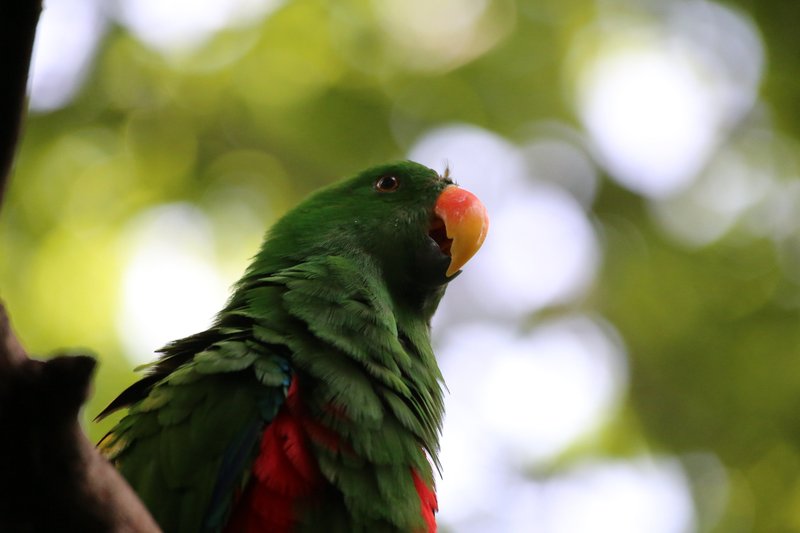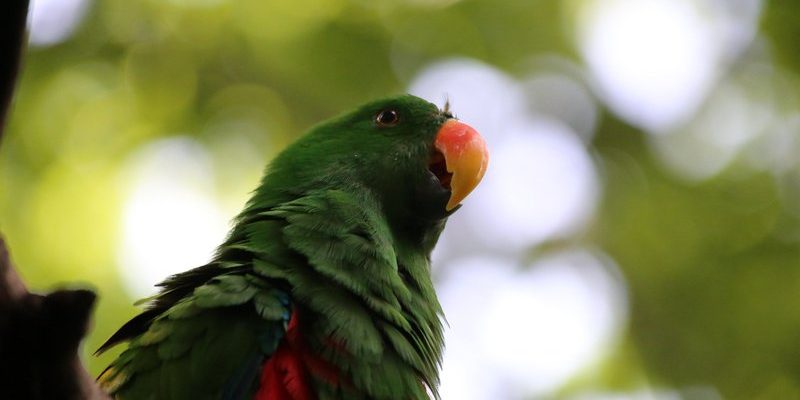
You might be wondering why these beautiful birds need our help. Imagine seeing a stunning piece of art in a museum, only to find out that it’s slowly fading away because of neglect. That’s the situation the Eclectus parrot finds itself in today. With habitat loss, illegal trapping, and climate change actively threatening their environment, conservation efforts are crucial to ensuring that future generations can experience the delight of these incredible birds.
In this article, we’ll dive into the various conservation efforts aimed at protecting the Eclectus parrot. We’ll explore the challenges they face and how various groups and individuals are working together to preserve their habitats and promote their survival.
Understanding The Eclectus Parrot: A Brief Overview
The Eclectus parrot is a striking bird, easily recognizable by its sexual dimorphism—meaning the males and females look significantly different. Male Eclectus parrots flaunt vibrant green feathers adorned with bright red and blue highlights on their wings, while females wear a bold red and purple plumage that makes them equally beautiful.
These birds are not just visually appealing; they’re also known for their intelligence and sociable nature. Eclectus parrots are great talkers and can mimic a range of sounds, making them popular pets. However, their wild counterparts are crucial for the ecosystem, as they help in seed dispersal, promoting forest growth.
Unfortunately, the Eclectus parrot population is dwindling due to several factors, such as deforestation and poaching. Their habitat is primarily found in tropical rainforests, which are being deteriorated at an alarming rate. As we explore different conservation efforts, it’s essential to understand what makes these parrots so special and why they deserve our protection.
The Threats Facing Eclectus Parrots
Several threats put the Eclectus parrot at risk, primarily due to human activities. Let’s break down these challenges:
- Habitat Loss: Deforestation is one of the most significant threats to the Eclectus parrot. As trees are cut down for timber and land is cleared for agriculture, these birds lose their natural homes. Without trees, they can’t find food or nesting sites, leading to declining populations.
- Illegal Trapping: The pet trade has also taken a toll. Eclectus parrots are sought after for their beauty and unique personalities, resulting in illegal trapping in the wild. This not only affects wild populations but also disrupts their social structures.
- Climate Change: Changes in climate can alter habitats, making it challenging for the Eclectus parrot to adapt. Increased temperatures and changing weather patterns lead to food scarcity and habitat degradation, threatening their survival.
These threats highlight the urgent need for effective conservation efforts to protect this species. Let’s delve into what is being done to counter these challenges.
Key Conservation Organizations and Their Efforts
Several organizations are pivotal in the conservation of the Eclectus parrot. These groups work diligently to protect their habitats and raise awareness about their plight. Here are some notable efforts:
- BirdLife International: This global partnership of conservation organizations aims to protect birds, including the Eclectus parrot. They focus on habitat protection and sustainable practices that benefit both wildlife and local communities.
- World Parrot Trust: Dedicated to the welfare of parrots worldwide, the World Parrot Trust works tirelessly to combat illegal trapping and promote breeding programs. They not only help educate the public but also offer resources for sustainable pet ownership.
- Local Conservation Groups: Many grassroots organizations in New Guinea and the surrounding islands are working to protect these parrots by engaging local communities in conservation efforts. They promote awareness and provide training for sustainable land use practices.
These organizations play a vital role in safeguarding the future of the Eclectus parrot. Their efforts demonstrate how collective action can lead to significant change and inspire new generations to care for wildlife.
Restoration of Natural Habitats
Restoring natural habitats is a fundamental component of conservation efforts for the Eclectus parrot. When you think about it, it’s like giving someone their home back after it’s been taken away. Many organizations focus on reforestation projects to replace the lost tree cover in areas where these parrots thrive.
Here are some ways habitat restoration is being implemented:
- Reforestation Initiatives: Planting native tree species is crucial for restoring the habitats of Eclectus parrots. These trees provide food and nesting sites, ensuring they have the resources they need to survive.
- Community Engagement: Local communities are often the best custodians of their surroundings. By involving them in restoration projects, organizations not only empower these communities but also create a sense of stewardship over the environment.
- Monitoring and Research: Ongoing research is essential to understand the Eclectus parrot’s needs. By studying their behavior, habitat preferences, and population dynamics, conservationists can make informed decisions about restoration projects.
Restoring the natural habitats of the Eclectus parrot increases the chances of their survival while enhancing biodiversity in the area. It’s a win-win for both the birds and the environment.
Protecting Eclectus Parrots from Illegal Trade
Combating illegal trade is another critical aspect of conserving the Eclectus parrot. As mentioned earlier, their beauty and intelligence make them prime targets for poaching. Here’s what’s being done to protect them:
- Legislation and Enforcement: Governments are strengthening laws against wildlife trafficking and increasing penalties for poachers. Stronger enforcement of these laws helps deter illegal trapping and trade.
- Education and Awareness: Informing potential buyers about the impact of illegal pet trade is vital. Organizations run campaigns to raise awareness about the importance of keeping Eclectus parrots in the wild, where they belong.
- Rescue and Rehabilitation: Organizations like the World Parrot Trust are working to rescue trapped or injured Eclectus parrots. They rehabilitate these birds and, when possible, reintroduce them into their natural habitats.
Efforts to combat illegal trade are crucial for protecting the Eclectus parrot and ensuring their populations can thrive in the wild.
Promoting Sustainable Practices
Sustainability plays a vital role in conservation efforts for the Eclectus parrot. Here’s why it matters:
- Forest Management: Sustainable logging practices ensure that trees are harvested without destroying entire habitats. This approach allows for local economies to benefit while preserving critical habitats for wildlife.
- Agricultural Practices: Encouraging farmers to adopt more sustainable methods can reduce habitat degradation. For instance, agroforestry combines agriculture with tree planting, providing both food and shelter for the Eclectus parrot.
- Community Education: Teaching local communities about sustainable practices empowers them to take ownership of their resources. When people have the knowledge and tools to manage their land responsibly, it benefits both wildlife and their livelihoods.
By promoting sustainable practices, we can help ensure that the Eclectus parrot and other wildlife have a safe environment to thrive in.
How You Can Help Conserve the Eclectus Parrot
You might be wondering how you can contribute to the conservation of the Eclectus parrot. Every little effort counts! Here are some simple ways to make a difference:
- Support Conservation Organizations: Donating to or volunteering with organizations dedicated to protecting wildlife helps fund their initiatives and outreach programs.
- Spread the Word: Share information about the Eclectus parrot and the conservation challenges they face with friends and family. The more people know, the greater the chance for collective action.
- Practice Responsible Pet Ownership: If you’re a bird lover and considering a pet parrot, choose to adopt from shelters or reputable breeders who prioritize the health and welfare of their birds.
Each of these steps, no matter how small, contributes to the overall conservation of the Eclectus parrot. Together, we can create a brighter future for these beautiful birds.
In conclusion, protecting the Eclectus parrot requires a concerted effort from conservation organizations, local communities, and individuals like you. By understanding the challenges they face and supporting initiatives aimed at preserving their habitats, we can ensure that these vibrant birds continue to grace our forests. Whether through education, restoration, or sustainable practices, every action counts in the fight for their survival. Let’s work together to keep the spirit of the Eclectus parrot alive for generations to come.

